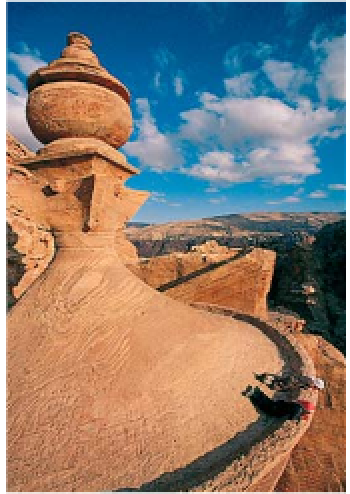Travel Reference
In-Depth Information
Other Sites Around Petra
Many of Petra's most famous sights can be visited in
half a day. However, having come so far, it would be a
pity not to explore more of this unique capital of a
vanished civilization. A full day is enough to do the
A
basic route from the ticket gate to the ancient city
(see
y
p228)
, taking in the Royal Tombs
(see p226)
, and to
include a walk to either the Monastery or the High Place
of Sacrifice. Two days will enable you to do the basic
route, both excursions and leave you with time to
explore the area around the Tomb of
T Sextius Florentinus.
Of the more distant sights, Little Petra can be visited in a
day, while two days should be allowed for Aaron's Tomb.
T
and several interesting carved
monuments along the way.
Finally, the path slips between
two boulders, and drops on to
a wide, once-colonnaded,
rock-cut terrace. Immediately
to the right is the
Monastery
,
Petra's most colossal temple,
dedicated to the deified king,
Obodas 1, who died in 86
BC. Although it resembles the
Treasury
High Place of Sacrifice: the round
altar with the main altar behind
Walk to the High Place
of Sacrifice
Midway between the Treasury
and the Theatre, a rock-cut
stairway, marked at the start
by several djinn blocks
(see
p222)
,
l
eads to the top of
Jebel Attuf mountain. It is here,
T
(see p224
y , it was
never as ornate, even when
statues adorned its niches. Its
simple, powerful architecture,
thought to date from the 1st
century AD, is seen by many
as the quintessential Nabataean
Classical design
(see p225
n . The
interior has one large chamber
with an arch-topped niche
where the altar stood. It came
to be known as the Monastery
because of the many Christian
crosses carved on its walls.
at 1,035 m (3,000 ft), that one
of the best preserved of Petra's
many places of sacrifice is
located. The ascent, while
gradual, requires stamina and
a good head for heights, and
is best attempted in the early
morning. The first part of the
summit is a large terrace with
two 6-m (20-ft) stone obelisks,
possibly fertility symbols. The
second, reached by a north-
wards scramble past the ruins
of a small Nabataean building,
is another plateau.
Here, just beyond a
rock-cut cistern, is
the
High Place of
Sacrifice
. In the
centre of a large
courtyard is a low
offering table. Steps
at the far end lead
up to the main altar,
which has a rectan-
gular indentation in
the top. The adjacent
round altar has a
basin with a carved
channel, quite possi-
bly for draining the
blood of animal and
human sacrifices.
The nearby cisterns
may have been used
for ritual ablutions.
The path winding
down the other side
of Jebel Attuf into
the Wadi Farasa
W
Façade of the Lion Triclinium
Walk to the Monastery
Just beyond the Qasr el-Bint
(see p228)
a path crosses the
Wadi Musa. It leads past the
W
Forum Restaurant to the start
of an arduous but thoroughly
worthwhile climb to one of
Petra's most awe-inspiring and
best-preserved monuments -
the Monastery. The path,
which cuts through the wadi,
is paved in parts and features
more than 800 rock-cut steps.
The afternoon, when the sun
is not directly in front, is the
best time to do this walk.
A short detour off the main
A
route, indicated by a Depart-
ment of Antiquities signpost,
leads to the
Lion Triclinium
.
This monument, with the
peculiar keyhole effect in the
façade, caused by erosion, has
blurred leonine representations
of the goddess al-Uzza guard-
ing its entrance. Its largely
Classical façade has unusually
ornate Nabataean features,
such as “horned” capitals with
floral scrollwork. After this, the
path to the Monastery rises
steeply. There are occasional
flights of steps through the
winding and narrowing gorge,
The Monastery's massive tholos crowned with
an urn resting on Nabataean “horned” capitals
For hotels and restaurants in this region see pp262-3 and pp279-80























